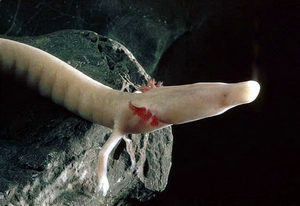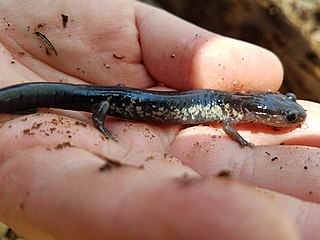
Plethodon is a genus of salamanders in the family Plethodontidae. They are also known as woodland salamanders or, more rarely, slimy salamanders. All members of the genus are endemic to North America. They have no aquatic larval stage. In some species, such as Plethodon cinereus, the red-backed salamander, eggs are laid underneath a stone or log. Young hatch in the adult form. Members of Plethodon primarily eat small invertebrates. The earliest known fossils of this genus are from the Hemphillian of Tennessee in the United States.

Wehrle's salamander is a species of salamander in the family Plethodontidae. It is endemic to the Eastern United States. It is named in honor of Richard White Wehrle (1852–1937), a jeweler, naturalist, and collector of the holotype.

Chiropterotriton, also known as splayfoot salamanders or flat-footed salamanders, is a genus of salamanders in the family Plethodontidae. The genus is endemic to Mexico.

The Cheoah Bald salamander is a species of salamander in the family Plethodontidae endemic to the state of North Carolina in the United States. Its natural habitat is temperate forests and it is threatened by habitat loss. It was formerly considered a variant of the red-cheeked salamander until it was found to be a distinct species.

The red-cheeked salamander, also known as the Jordan's salamander, Jordan's redcheek salamander, or Appalachian woodland salamander, is a species of salamander in the family Plethodontidae. It is endemic to the Appalachian Mountains in the eastern United States.
The South Mountain gray-cheeked salamander is a species of salamander in the family Plethodontidae, endemic to the state of North Carolina in the United States, where it is only found in the South Mountains. It was formerly considered a variant of the red-cheeked salamander. Its natural habitat is temperate forests. It is threatened by habitat loss.
The Sequoyah slimy salamander is a species of salamander in the family Plethodontidae.

Weller's salamander is a species of salamander in the family Plethodontidae. This species in endemic to the southeastern mountain range of the United States. It is mainly found in North Carolina near Grandfather Mountain. The salamanders have a unique metallic spotting which distinguishes them from other Plethodon species and other salamanders in the area. They mainly inhabit cool forests with rocky areas.

A cave salamander is a type of salamander that primarily or exclusively inhabits caves, a group that includes several species. Some of these animals have developed special, even extreme, adaptations to their subterranean environments. Some species have only rudimentary eyes. Others lack pigmentation, rendering them a pale yellowish or pinkish color.

The Chattahoochee slimy salamander (Plethodon chattahoochee) is a species of salamander in the family Plethodontidae. It is endemic to the Appalachian Mountains in the United States, where it is found only in the Chattahoochee National Forest and Nantahala National Forest in the states of Georgia and North Carolina. Its natural habitat is temperate forests. It was once classified within the northern slimy salamander (P. glutinosus) until it was found to be a distinct species. Its range narrowly intersects with the northern slimy salamander, the Atlantic Coast slimy salamander (P. chlorobryonis), and the southern Appalachian salamander (P. teyahalee) and widely intersects with the red-legged salamander (P. shermani), and it is known to hybridize with the latter three.

The Atlantic Coast slimy salamander is a species of salamander in the family Plethodontidae. It is endemic to the United States, where it is distributed throughout the Southeastern United States from southeastern Virginia to northern Georgia. It is largely distributed along the Atlantic coastal plain, although it enters the Piedmont in Virginia and South Carolina and enters the Blue Ridge Mountains in Georgia. Its habitat is largely restricted to bottomland hardwood forest. While its conservation status is considered Secure by NatureServe, declines have been noted in all studied populations.

The southeastern slimy salamander is a species of salamander in the family Plethodontidae. It is endemic to the United States, where it is distributed in the Southeastern United States from southern Georgia west to Alabama and south to central Florida. Its natural habitats are steephead valleys, maritime forests and bottomland hardwood forests.
The Ocmulgee slimy salamander is a species of salamander in the family Plethodontidae. It is endemic to the state of Georgia in the United States, where it is found in regions of the coastal plain and Piedmont that are associated with the Ocmulgee River drainage system. It is only known from a few counties, and due to this restricted range, it is at high risk of extinction. Many populations of this species are already experiencing precipitous declines, with some even possibly being extirpated.
The Savannah slimy salamander is a species of salamander in the family Plethodontidae. It is endemic to the state of Georgia in the United States, where it is restricted to the Atlantic coastal plain in Burke, Jefferson, and Richmond counties. This distribution reaches its eastern limit at the Savannah River. Its natural habitat is bottomland hardwood forest. Population analysis indicates a precipitous decline in the population of this species, and it is becoming extirpated in many areas due to development; for example, the habitat at the type locality of this species was partially destroyed by a housing development.

The South Carolina slimy salamander is a species of salamander in the family Plethodontidae. It is endemic to the south-eastern United States, where it is restricted to a small portion of the Atlantic coastal plain from South Carolina to extreme south-eastern Georgia. Its natural habitats are mixed forests, bottomland hardwood forests, and longleaf pine savannas.
The Blacksburg salamander is a species of salamander in the family Plethodontidae. It is endemic to the Southeastern United States, where it is restricted to the Appalachian Mountains in southwestern Virginia and northwestern North Carolina. It is named after the town of Blacksburg, Virginia, as its first recorded sighting was within its vicinity. Its natural habitat is temperate forest.
The yellow-spotted woodland salamander is a species of salamander in the family Plethodontidae. It is endemic to the United States, where it is distributed throughout the Cumberland Plateau in the states of Kentucky and Tennessee. Its natural habitat is temperate forest. It was long considered to be both an isolated western population and a unique yellow-spotted color morph of the Wehrle's salamander, but a study published in 2019 found it to be a distinct species.










